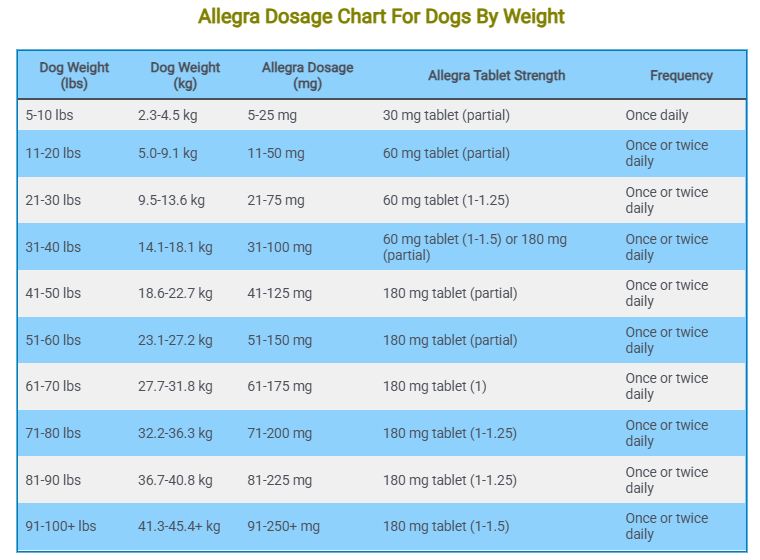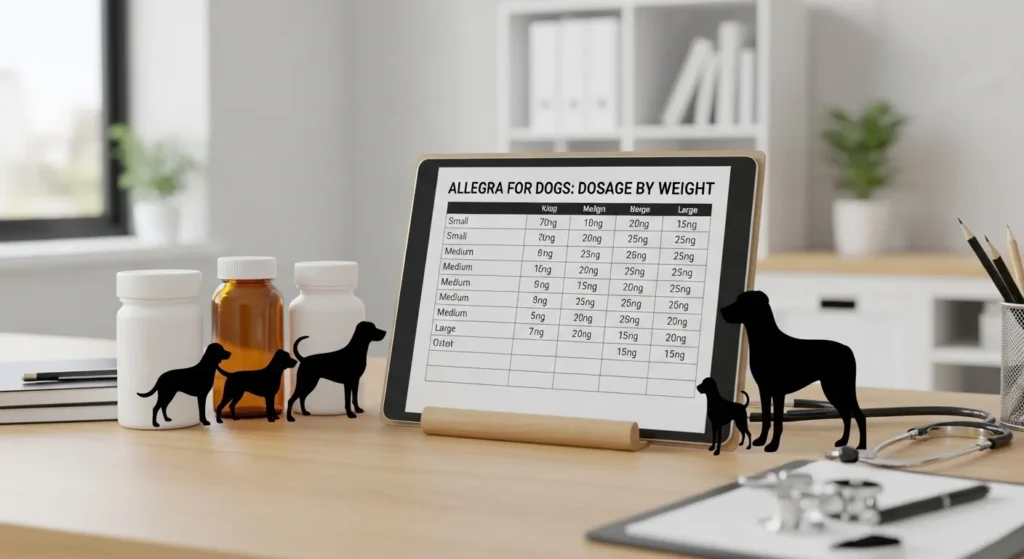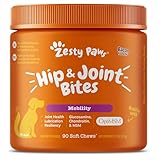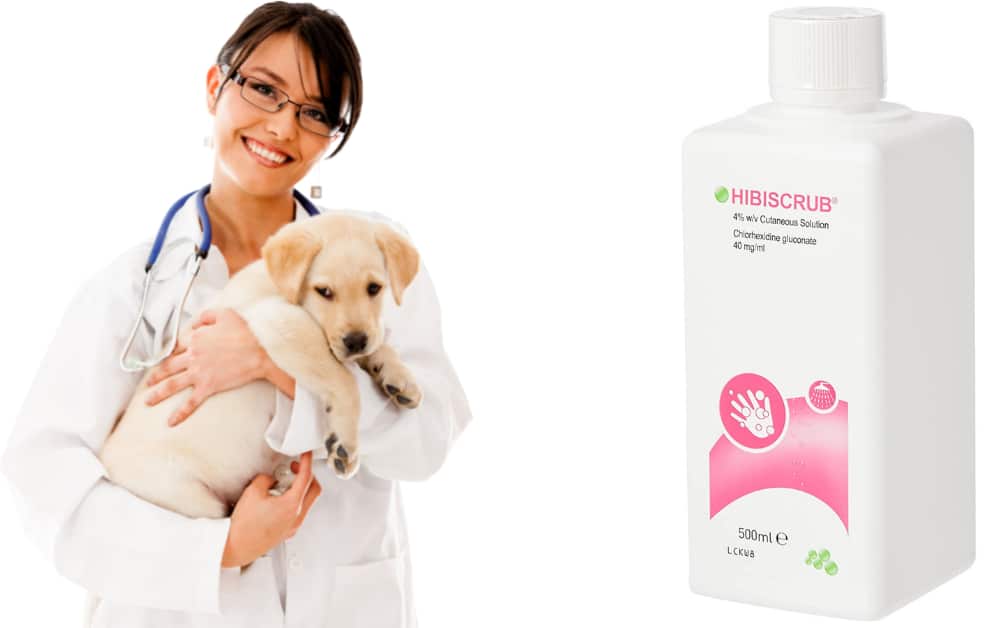As a loving dog owner, watching your furry friend suffer from allergies can be heartbreaking. The constant scratching, licking, and discomfort can affect their quality of life—and yours. If you’re wondering whether Allegra (fexofenadine) could help relieve your dog’s allergy symptoms, you’ve come to the right place.
This comprehensive guide covers everything you need to know about using Allegra for dogs, including a detailed dosage chart by weight, safety guidelines, potential side effects, and much more to help you make informed decisions about your pet’s health.
Key Takeaways
- Allegra (fexofenadine) is a second-generation antihistamine that can help reduce allergy symptoms in dogs
- The recommended dosage is 1-2.5 mg per pound of body weight, given once or twice daily
- Only use plain Allegra formulations—avoid Allegra-D and children’s liquid formulas containing xylitol
- Always consult your veterinarian before giving your dog any human medication
- While generally safe, Allegra may not be suitable for dogs with kidney disease, pregnant/nursing dogs, or those with hypersensitivity to the ingredients
What Is Allegra For Dogs?
Allegra, which contains the active ingredient fexofenadine, is a second-generation antihistamine commonly used by humans to treat allergy symptoms. Many pet owners wonder if they can give their dogs Allegra to help with similar issues. The answer is yes—but with important caveats.
Unlike first-generation antihistamines like Benadryl, Allegra is considered non-drowsy, making it less effective for treating anxiety or causing sedation in dogs. However, it can be quite effective for reducing the uncomfortable symptoms associated with allergies in canines.
According to veterinary research, Allegra (fexofenadine) has shown promise in treating allergy-related itching in dogs with atopic dermatitis. While not specifically approved for veterinary use by the FDA, many veterinarians do prescribe it as an “off-label” treatment when appropriate.
Allegra Dosage For Dogs Chart By Weight
Determining the correct dosage of Allegra for your dog is crucial for both safety and effectiveness. The recommended dosage is 1-2.5 mg per pound of body weight, given either once or twice daily depending on your veterinarian’s preference.
Allegra Dosage Chart For Dogs By Weight
| Dog Weight (lbs) | Dog Weight (kg) | Allegra Dosage (mg) | Allegra Tablet Strength | Frequency |
|---|---|---|---|---|
| 5-10 lbs | 2.3-4.5 kg | 5-25 mg | 30 mg tablet (partial) | Once daily |
| 11-20 lbs | 5.0-9.1 kg | 11-50 mg | 60 mg tablet (partial) | Once or twice daily |
| 21-30 lbs | 9.5-13.6 kg | 21-75 mg | 60 mg tablet (1-1.25) | Once or twice daily |
| 31-40 lbs | 14.1-18.1 kg | 31-100 mg | 60 mg tablet (1-1.5) or 180 mg (partial) | Once or twice daily |
| 41-50 lbs | 18.6-22.7 kg | 41-125 mg | 180 mg tablet (partial) | Once or twice daily |
| 51-60 lbs | 23.1-27.2 kg | 51-150 mg | 180 mg tablet (partial) | Once or twice daily |
| 61-70 lbs | 27.7-31.8 kg | 61-175 mg | 180 mg tablet (1) | Once or twice daily |
| 71-80 lbs | 32.2-36.3 kg | 71-200 mg | 180 mg tablet (1-1.25) | Once or twice daily |
| 81-90 lbs | 36.7-40.8 kg | 81-225 mg | 180 mg tablet (1-1.25) | Once or twice daily |
| 91-100+ lbs | 41.3-45.4+ kg | 91-250+ mg | 180 mg tablet (1-1.5) | Once or twice daily |
Example: A 30 lb dog could be given one 60 mg Allegra tablet once or twice daily for a 2 mg/lb dosage.
How Does Allegra Work in Dogs?
Allegra works by blocking histamine receptors in your dog’s body. Histamine is a chemical that the immune system releases in response to allergens. It’s what causes those classic allergy symptoms like itching, redness, swelling, and inflammation.
When your dog ingests Allegra, the fexofenadine binds to the H1 receptors, preventing histamine from attaching to these cells. This action helps reduce or eliminate allergy symptoms, providing relief for your furry friend.
Unlike some other antihistamines, fexofenadine doesn’t easily cross the blood-brain barrier, which is why it’s less likely to cause drowsiness—a benefit if you want your dog to remain alert and active during treatment.
How to Administer Allegra to Dogs
Administering medication to dogs can sometimes be challenging, but with these tips, you can make the process smoother for both you and your pet:
- Choose the right formulation: Use plain Allegra tablets rather than gelcaps, as they’re easier to split if needed for accurate dosing.
- Hide the medication: Most dogs will readily eat a pill hidden in a small amount of peanut butter (xylitol-free), cheese, or a soft treat.
- Use a pill dispenser: If your dog is skilled at finding and spitting out pills, a pill dispenser (sometimes called a “pill gun”) can help place the pill at the back of their throat.
- Crush with caution: Only crush Allegra tablets if your veterinarian approves, as this can affect how the medication is absorbed.
- Be consistent: Try to give the medication at the same time(s) each day to maintain consistent levels in your dog’s system.
- Avoid fruit juice: While unlikely you’re giving your dog fruit juice, it’s important to note that the medicine should not be given with fruit juice, as it can affect how the drug is absorbed.
Formulations to Avoid
Not all Allegra products are safe for dogs. Some formulations contain additional ingredients that can be harmful to your furry friend. Avoid giving your dog the following formulations:
Allegra-D
Allegra-D contains pseudoephedrine, which can be dangerous for dogs. Pseudoephedrine can cause symptoms ranging from mild agitation to severe tremors, seizures, elevated heart rate, and even death in dogs. Never give your dog any medication containing decongestants unless specifically prescribed by your veterinarian.
Children’s Oral Suspension (Liquid)
The liquid formulation of Allegra designed for children contains xylitol, an artificial sweetener that is highly toxic to dogs. Xylitol can cause a rapid release of insulin in dogs, leading to hypoglycemia (low blood sugar), which can be life-threatening.
Meltable Tablets
The meltable tablets were designed to work for humans and may contain ingredients that aren’t appropriate for dogs. Your veterinarian can help you determine if this formulation is safe for your pet.
When in doubt, always check the active ingredients on the label and consult with your veterinarian before giving any medication to your dog.
Safety Guidelines
While Allegra is generally considered safe for dogs when used appropriately, following these safety guidelines is essential:
- Veterinary consultation: Never give Allegra to your dog without the approval and guidance of your veterinarian. They can determine if Allegra is appropriate for your dog’s specific condition and calculate the correct dosage.
- Avoid toxic ingredients: Do not use products containing xylitol, pseudoephedrine, or any other substances that are toxic to dogs.
- Disclose medical history: Tell your veterinarian about any medical conditions affecting your dog, especially kidney disease, and any other medications or supplements you’re giving them.
- Monitor for side effects: Keep an eye on your dog after administering Allegra and report any unusual symptoms to your veterinarian.
- Start with the lowest effective dose: Begin with the lowest recommended dose (1 mg/lb) and only increase if necessary and under veterinary guidance.
- Store safely: Keep all medications out of reach of your pets to prevent accidental ingestion.
Is Allegra Safe for All Dogs?
While Allegra is generally considered safe for most dogs, it may not be suitable for every canine. The medication may be inappropriate for dogs who:
- Are pregnant or nursing
- Have poor kidney function or kidney disease
- Are hypersensitive to any ingredients in the medicine
- Have certain heart conditions (as antihistamines can affect heart function at high doses)
There is currently limited information on the safety of fexofenadine for dogs. However, some studies have suggested that the drug is safe and effective for treating allergy-related itching in dogs when compared to methylprednisolone. The drug has also been given to dogs at dosages of up to 2 g/kg without signs of toxicity, and doses of 18 mg/kg are seemingly safe (though this doesn’t mean you should exceed the recommended 1-2.5 mg/lb dosage).
Always consult with your veterinarian before giving your dog any new medication, including Allegra.
Potential Side Effects
Allegra is generally well-tolerated by dogs, but like any medication, it can cause side effects in some cases. Based on human reports and limited veterinary data, the following side effects may be possible:
- Headaches (though difficult to detect in dogs)
- Nausea or vomiting
- Digestive upset or indigestion
- Drowsiness (despite being classified as non-drowsy, sedation is possible, though rare)
- Decreased appetite
Although the medicine is considered non-drowsy, sedation is possible (yet rare), and becomes more common as the dosage increases. Second-generation antihistamines may also negatively affect the heart at high doses, which is why sticking to the recommended dosage is crucial.
If you notice any concerning symptoms after giving your dog Allegra, contact your veterinarian immediately.
When to Consult Your Vet
While mild allergies might seem manageable with over-the-counter medications like Allegra, there are times when veterinary care is essential. Consult your veterinarian if:
- Your dog’s allergy symptoms are severe or worsening
- You notice skin lesions, hair loss, or changes in skin color
- Your dog is experiencing gastrointestinal issues like vomiting or diarrhea
- Your dog seems lethargic or is showing behavioral changes
- You’re unsure about the appropriate dosage or formulation
- Your dog has pre-existing health conditions, especially kidney or heart disease
Remember that while Allegra can help manage allergy symptoms, it doesn’t address the underlying cause of the allergies. Your veterinarian can help identify and address the root cause of your dog’s allergies for long-term relief.
Alternatives to Allegra for Dogs
If Allegra isn’t suitable for your dog or isn’t providing adequate relief, there are several alternatives your veterinarian might recommend:
Other Antihistamines
- Benadryl (diphenhydramine): A first-generation antihistamine that can cause drowsiness but is often effective for allergy symptoms in dogs.
- Zyrtec (cetirizine): Another second-generation antihistamine that may be used for dogs with allergies.
- Claritin (loratadine): Similar to Allegra, this antihistamine is sometimes prescribed for dogs with allergies.
Prescription Medications
- Apoquel (oclacitinib): A prescription medication specifically designed to treat itching and inflammation in dogs with allergies.
- Cytopoint: An injectable treatment that targets and neutralizes one of the main proteins that causes itchiness in dogs.
Supplements and Topical Treatments
- Omega-3 fatty acids: Can help reduce inflammation and improve skin health.
- Medicated shampoos: Can provide relief from itching and help remove allergens from the skin.
- Hypoallergenic diets: If food allergies are suspected, a special diet may be recommended.
Always consult with your veterinarian before starting any new treatment for your dog’s allergies.
Read More from Our Dog Medication Guide:
FAQs
Can I give my dog human Allegra?
Yes, you can give your dog plain Allegra (fexofenadine) that’s formulated for humans, but only with your veterinarian’s approval and guidance. Avoid formulations like Allegra-D that contain pseudoephedrine, which is toxic to dogs.
How long does it take for Allegra to work in dogs?
Allegra typically begins working within 1-2 hours of administration. However, it may take several days of consistent dosing to see the full effect on your dog’s allergy symptoms.
Can I give my dog Allegra every day?
Yes, if recommended by your veterinarian, Allegra can be given daily for chronic allergy management. However, it’s important to follow the dosing schedule prescribed by your vet and to have regular check-ups to monitor your dog’s response to the medication.
Is Allegra better than Benadryl for dogs?
Allegra and Benadryl work differently, and which is “better” depends on your dog’s specific needs. Allegra is less likely to cause drowsiness, while Benadryl may be more effective for some dogs but often causes sedation. Your veterinarian can help determine which medication is more appropriate for your dog.
Final Thoughts
Allergies can make your dog miserable, but with the right treatment approach, you can help them find relief. Allegra (fexofenadine) can be an effective option for managing allergy symptoms in dogs when used appropriately under veterinary guidance.
Remember to always consult with your veterinarian before giving your dog any medication, including Allegra. They can help determine if it’s the right choice for your pet, calculate the correct dosage based on your dog’s weight, and monitor for any potential side effects.
By working closely with your veterinarian and following the guidelines outlined in this article, you can help your furry friend feel more comfortable and enjoy a better quality of life, free from the constant itching and discomfort of allergies.
Your dog relies on you to make the best decisions for their health. With the right information and veterinary support, you can help them find relief from allergies and get back to enjoying their favorite activities—scratch-free!










